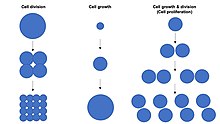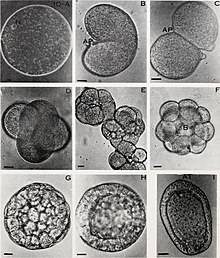
| Part of a series on |
| Biology |
|---|
Cell growth refers to an increase in the total mass of a cell, including both cytoplasmic, nuclear and organelle volume.[1] Cell growth occurs when the overall rate of cellular biosynthesis (production of biomolecules or anabolism) is greater than the overall rate of cellular degradation (the destruction of biomolecules via the proteasome, lysosome or autophagy, or catabolism).[2][3][4]
Cell growth is not to be confused with cell division or the cell cycle, which are distinct processes that can occur alongside cell growth during the process of cell proliferation, where a cell, known as the mother cell, grows and divides to produce two daughter cells.[1] Importantly, cell growth and cell division can also occur independently of one another. During early embryonic development (cleavage of the zygote to form a morula and blastoderm), cell divisions occur repeatedly without cell growth. Conversely, some cells can grow without cell division or without any progression of the cell cycle, such as growth of neurons during axonal pathfinding in nervous system development.

In multicellular organisms, tissue growth rarely occurs solely through cell growth without cell division, but most often occurs through cell proliferation.[1] This is because a single cell with only one copy of the genome in the cell nucleus can perform biosynthesis and thus undergo cell growth at only half the rate of two cells. Hence, two cells grow (accumulate mass) at twice the rate of a single cell, and four cells grow at 4-times the rate of a single cell. This principle leads to an exponential increase of tissue growth rate (mass accumulation) during cell proliferation, owing to the exponential increase in cell number.
Cell size depends on both cell growth and cell division, with a disproportionate increase in the rate of cell growth leading to production of larger cells and a disproportionate increase in the rate of cell division leading to production of many smaller cells. Cell proliferation typically involves balanced cell growth and cell division rates that maintain a roughly constant cell size in the exponentially proliferating population of cells.
Some special cells can grow to very large sizes via an unusual endoreplication cell cycle in which the genome is replicated during S-phase but there is no subsequent mitosis (M-phase) or cell division (cytokinesis). These large endoreplicating cells have many copies of the genome, so are highly polyploid.
Oocytes can be unusually large cells in species for which embryonic development takes place away from the mother's body within an egg that is laid externally. The large size of some eggs can be achieved either by pumping in cytosolic components from adjacent cells through cytoplasmic bridges named ring canals (Drosophila) or by internalisation of nutrient storage granules (yolk granules) by endocytosis (frogs).
- ^ a b c Conlon, Ian; Raff, Martin (1999). "Size Control in Animal Development". Cell. 96 (2): 235–244. doi:10.1016/S0092-8674(00)80563-2. ISSN 0092-8674. PMID 9988218. S2CID 15738174.
- ^ Grewal, Savraj S; Edgar, Bruce A (2003). "Controlling cell division in yeast and animals: does size matter?". Journal of Biology. 2 (1): 5. doi:10.1186/1475-4924-2-5. ISSN 1475-4924. PMC 156596. PMID 12733996.
- ^ Neufeld, Thomas P; de la Cruz, Aida Flor A; Johnston, Laura A; Edgar, Bruce A (1998). "Coordination of Growth and Cell Division in the Drosophila Wing". Cell. 93 (7): 1183–1193. doi:10.1016/S0092-8674(00)81462-2. ISSN 0092-8674. PMID 9657151. S2CID 14608744.
- ^ Thompson, Barry J. (2010). "Developmental control of cell growth and division in Drosophila". Current Opinion in Cell Biology. 22 (6): 788–794. doi:10.1016/j.ceb.2010.08.018. PMID 20833011.